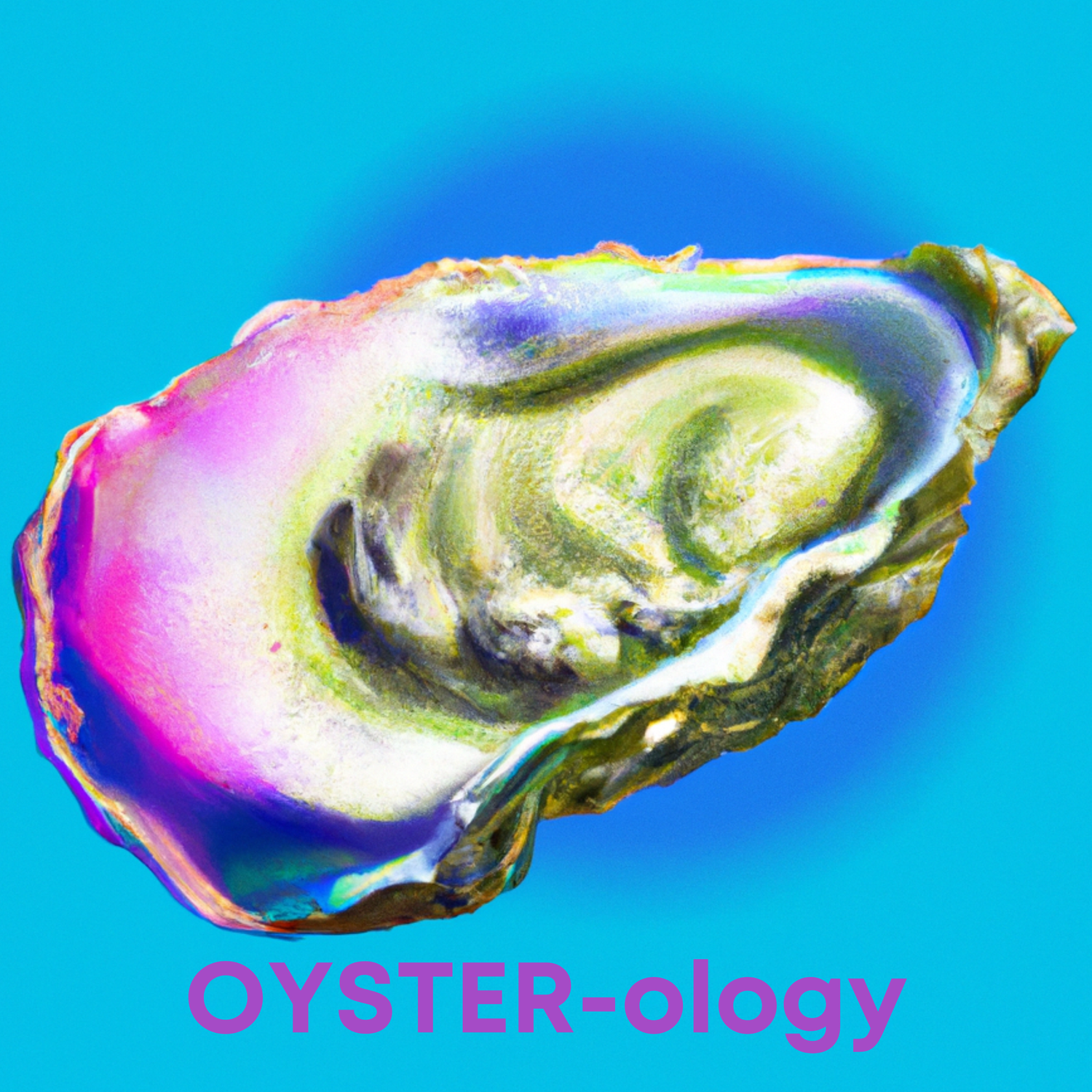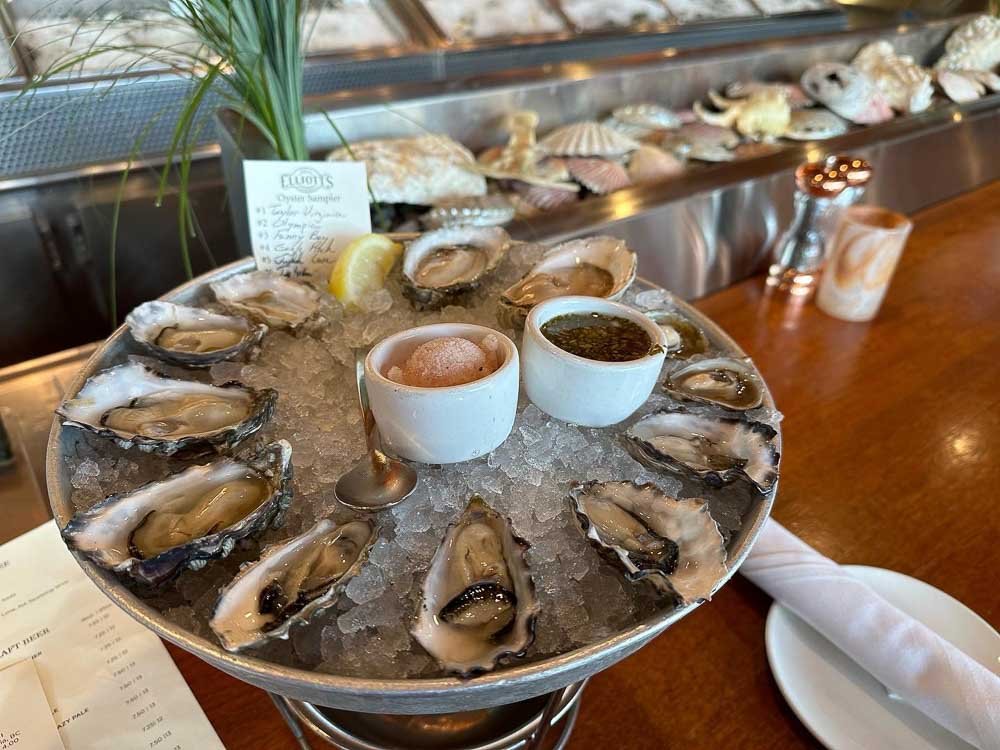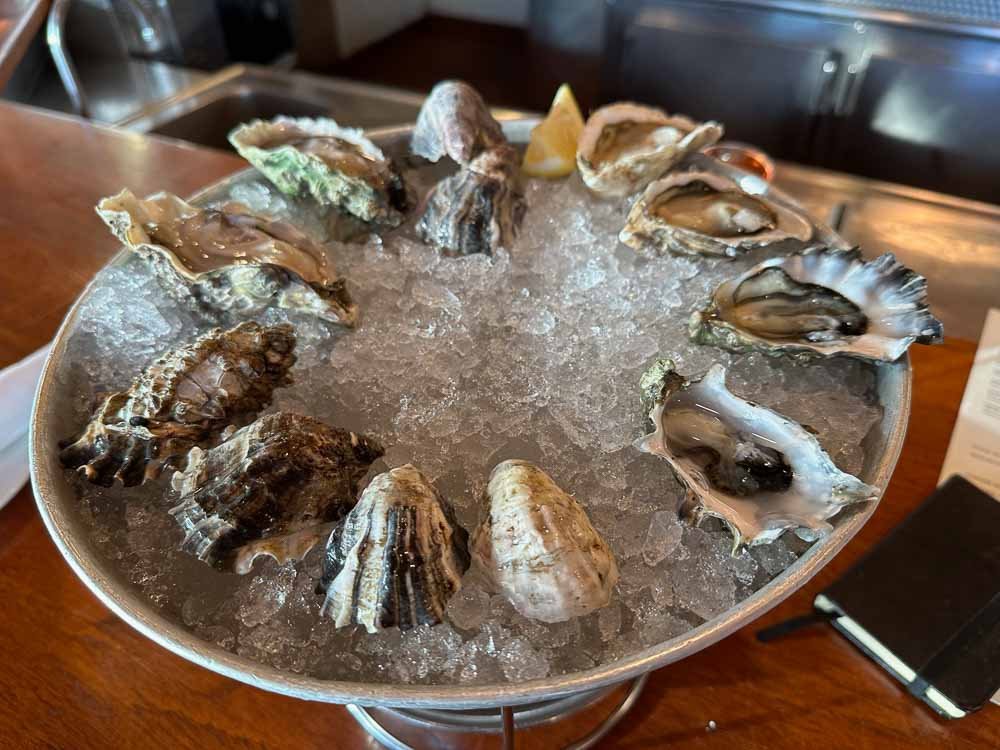A half day of half shells: Oyster Exploration at Elliott’s
/As I’ve been eating my way around the oyster world of Washington State I have tried many different oysters, each with their own names, character and taste. It’s remarkable to me how much influence a region, water and style of growing has on oysters which, as with all Pacific oysters (crassostrea gigas) are the same animal. Yet each is different from the other, some with only slight distinctions; others like eating different creatures altogether. So it quickly becomes challenging to keep track of them – which tasted briny, which was sweet, or vegetal or minerally, or, or or… While I am not one to rank restaurants or foods – instead appreciating each item or place for which it is rather than what it isn’t – it’s hard not to compare oysters to determine which I prefer. Studying my tasting notes is one academic approach to sorting it all out, but sitting down in front of a large lineup of different oysters at one time, with cold beer to wash it all down, seemed like a much better idea. So I headed over to Seattle’s waterfront and the well respected temple of all things oyster: Elliottt’s Oyster House.
Elliot’s is legendary in Seattle and has been operating since 1975 directly on Elliott Bay – I mean literally built on the old wooden Pier 56 where prospectors once launched their gold rushes in the 1800’s. It’s easy to dismiss Elliott’s as a tourist joint, given its location and prominence in brochures at nearly every Seattle hotel lobby. But overlooking Elliott’s would be a mistake for anyone who appreciates oysters. It’s a bastion of bivalves with a large oyster bar to sidle up to and sample on any given day up to 24 different oysters, shucked fresh by the oyster experts standing by. Sure, you could sit at a table, order off a menu and include a dozen halfshells like most customers do. But if oysters are what brings you to Elliott’s you really should head straight to the oyster bar and grab a stool, order a beer and give yourself over to your new best oysterman friend. Which is exactly what I did.
Stepping into the restaurant, I could immediately tell that this place was the real deal. A bustling atmosphere with the unmistakable aroma of saltwater, the front-and-center raw bar was the first thing I saw. Piles of shimmering oysters sat in their stainless bins behind the bar, waiting to be shucked to order by the skilled hands of the oystermen greeting me as I sat.
As I perused the lineup of the day’s oysters – fresh from the cold, clean waters of the Pacific Northwest, I felt like a kid in a candy store. The oyster selection was exciting, with each variety boasting its own unique flavor profile. I was immediately greeted by the three people who would guide me on my sampling experience: Oyster Boss Doug, Shucker “Truth” and server/trusted flavor advisor Franchesca. And since I was deeply engrossed in, y’know, research, I needed to try as many unfamiliar varieties as I could, plus a few repeats for comparison purposes, of course. Franchesca was there to steer me down a logical path, starting locally with Washington Pacifics, then meandering north to Canada and returning to Washington Japanese species. This meant no fewer than two each of 16 different oysters, not to mention an unclear number of “extras” that the guys shucking slid over to me in the midst of our conversation. As she advised the order in which to taste, Doug explained all about them while Truth shucked and served. Together the four of us made a formidable Oyster-killing team, with each of them slipping a slurp of their own along with me every now and then.
Without waxing too poetic on the various flavors, mouth-feel, and complexion of each oyster I consumed, here is a quick-hit account of my journey complete with my purely-subjective 0-5 ratings:
Hood Canal Pacifics: (c. gigas) Hood Canal, WA. Beach grown. Light brine with a hint of nutty sweetness. Add 2 drops of Star of Bombay gin to make it crazy good. 4/5
Olympic: (o. lurida) S. Puget Sound, WA. Beach grown. Meaty and briny, evolving to cucumber with a long finish. 2/5
Baywater Sweet: (c. gigas) Hood Canal, WA. Rack & Bag. Nose like the perfect ocean cove. Slight brine evolving into multidimensional Spring lettuce/sweet cucumber. Meaty and fabulous. 5/5.
Summerstone: (c. gigas) Port Hadlock, WA. Bag to Beach. Metallic attack with iodine undertone, but then rounding out to mild cucumber finish. Creamy with big flavor. 3/5
Hammersly: (c. gigas) N. Puget Sound. Briny attack quickly turning to fruity vegetal middle and rich umami finish. Like a big, friendly Golden Retriever, this one was hard not to love. 4/5
Taylor Virginica: (c. virginica) Totten Bay, S. Puget Sound, WA Beach Grown. The only virginicas grown on the West Coast. Medium brine reminiscent of its Eastern oyster genesis but with a bright, fruity finish. A unique hybrid of East and West Coast oysters. A champion of an oyster, it stands up to any extended family member in the Chesapeake Bay. 5/5
Fanny Bay: (c. gigas) Vancouver Island, BC. Rack & Bag. Brine, brine, brine with tasty yet one-note ocean-y length throughout until a little sweet on finish. Nice deep cups with thick meat and loads of liquor. 3/5
Judd Cove: (c.gigas) Orcas Island, WA. Rack & Bag. Big, strong and minerally flavor. Salty, gun metal essence with .44 magnum firepower. 3/5
Eagle Rock: (c. gigas) Totten Inlet, WA. Bag to beach. Flat and mild with a little lettuce wrapped around gun metal. Small and innocuous and easily forgotten. 2/5
Kumamoto: (c. sikamea) Totten Inlet, S. Puget Sound, WA. Small, deep-bowl cups and a balance of silky meat and butter texture together in one bite. A light brine on the lips, flowing into a sweet, vegetal middle and hint of metal on the end. From its thick, tumbled shell to its all-encompassing flavor rainbow, this is the Subaru Outback of oysters in the Pacific Northwest - to try them is to love them. 5/5
Ichiban: (c. sikamea) Skagit Bay, WA. Rack & Bag.. Small, deep cup filled with sweet liquor and little chunk of delicate fruit and grass. Similar to a Kumamoto, this Japanese hybrid is a little sweeter and good for anyone. 5/5
Stellar Bay: (c. gigas) Vancouver Island, BC. Rack & Bag. Sophisticated flavor starting with big brine dropping to lite cucumber and iodine. Nice deep cup and lots of liquor, most suitable for a more experienced, mineral-seeking oyster palate. 3/5
Olympia: (o.lurida) Totten, S. Puget Sound, WA. Beach grown. Copper, mineral and metallic – like sucking on a penny. Very small and flat, it’s the only truly indigenous oyster to WA. No sweetness but briny affront with good umami length that keeps on giving. A different oyster tasting experience. 2/5
Kusshi: (c. sikamea) Baynes Sound, BC. Rack & Bag. Deep cups, purple stripes, a big swallow of liquor with a sweet, chewy chunk of firm, silky meat. Sweet and vegetal, lettuce and melon. Their small size and mild flavor make them an oyster for anyone and arguably a Kuma-killer given the price per unit difference. 5/5
Oishi: (c. sikamea) Skagit Bay, WA. Rack & Bag. All sweet and fruity with strong melon notes. Small and firm with a gentle liquor wash, they are mostly one-note, but in a good way. 3/5
Mirimichi: (c. sikamea) totten Inlet, WA. Bag to Beach. Great balance between sweet and savory, with a nutty, lingering finish. A complex taste, its deep cup and firm meat was reminiscent of the Oishi, but more complex and better. 5/5
As I savored each oyster, I couldn't help but marvel at the incredible range of flavors and textures that can be found within such a simple and humble ingredient. In some cases, the difference were minor and nuanced; in others – like the Taylor Virginica — the oyster stood proudly apart from all others. And as an added bonus I discovered some unstated facts about oyster people: they like to eat while they talk oysters and they love to share. You want to eat a lot of oysters? Just get into a conversation with an oysterman — halfshells always seem to follow. The more the conversation went on, the more oysters came my way. All of my tastes were discussed with my oyster masters, along with other hot topics like East Coast v. West Coast in the oyster world and Pacificas from the Gulf of Mexico “The same, but different – that dirty warm water kills the flavor and risks disease and they’re flaccid compared to ours up here,” frowns Bossman Doug. The guy holds up a fat, local oyster as an example of the good stuff, and passes it to me. He displays the differences in shell shape, or depth, or thickness and shucks a few examples, slipping them to me to prove his point. On the topic of speed-shucking, Truth smirks and rolls his eyes “Yeah, those guys may be fast, but what about the finished shuck? Don’t look at that mess too closely!” He says while proudly passing a perfectly-shucked exemplar to me. It’s all about great food served up with commentary and hyperbole from guys who know best… Short of standing in water up to your chest in the middle of an oyster farm, there is no better way to enjoy a bivalve. I mean, who needs Michelin stars when you can throw back a few dozen half shells while talking with the pros at a sleek joint on the edge of Puget Sound? And, yes, while confirming the lore of Seattle’s high prices for good food, these oysters were worth every penny. So when I finally prepared to leave I couldn't help but feel a twinge of sadness as I finished off my last oyster – fighting notions emerging in my brine-soaked brain of shirking all familial responsibility and established way of life to become a full-time oyster farmer. Or at least of becoming an oysterholic slumping over the coolest bivalve bar in town.
Elliott’s Oyster House, 1201 Alaskan Way, Seattle













